A numerical optimization of high altitude testing facility for wind tunnel experiments
A numerical optimization of high altitude testing facility for wind tunnel experiments作者机构:Department of Aeronautical Engineering Regional Centre of Anna University Department of Mechanical Engineering University College of EngineeringNagercoil Department of Aeronautical Engineering The Raajas Engineering College
出 版 物:《Chinese Journal of Aeronautics》 (中国航空学报(英文版))
年 卷 期:2015年第28卷第3期
页 面:636-648页
核心收录:
学科分类:08[工学] 080103[工学-流体力学] 0802[工学-机械工程] 0825[工学-航空宇航科学与技术] 080201[工学-机械制造及其自动化] 0801[工学-力学(可授工学、理学学位)]
基 金:DRDO
主 题:CFD Enclosed free-jet section Ground testing High altitude testing (HAT)facility Optimization
摘 要:Abstract High altitude test facilities are required to test the high area ratio nozzles operating at the upper stages of rocket in the nozzle full flow conditions. It is typically achieved by creating the ambient pressure equal or less than the nozzle exit pressure. On average, air/GN2 is used as active gas for ejector system that is stored in the high pressure cylinders. The wind tunnel facilities are used for conducting aerodynamic simulation experiments at/under various flow velocities and operating conditions. However, constructing both of these facilities require more laboratory space and expensive instruments. Because of this demerit, a novel scheme is implemented for conducting wind tunnel experiments by using the existing infrastructure available in the high altitude testing (HAT) facility. This article presents the details about the methods implemented for suitably modifying the sub-scale HAT facility to conduct wind tunnel experiments. Hence, the design of nozzle for required area ratio A/A*, realization of test section and the optimized configuration are focused in the present analysis. Specific insights into various rocket models including high thrust cryogenic engines and their holding mechanisms to conduct wind tunnel experiments in the HAT facility are analyzed. A detailed CFD analysis is done to propose this conversion without affecting the existing functional requirements of the HAT facility.



